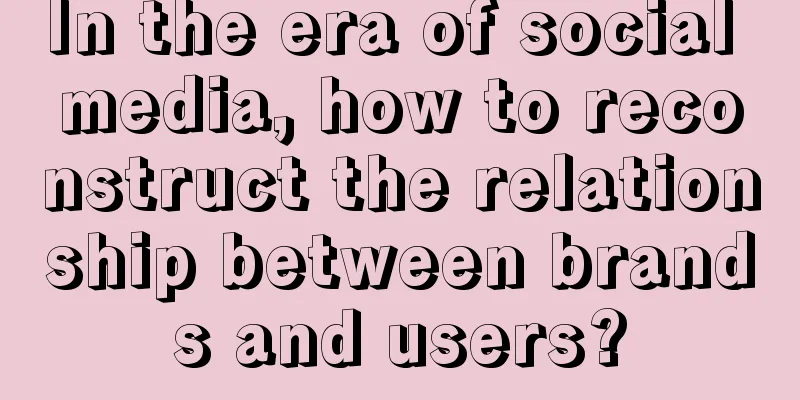In the era of social media, how to reconstruct the relationship between brands and users?

From the resurgence of domestic brands such as Tong Ren Tang, Hua Xizi, Li Ning, and White Rabbit Milk Candy, to the sudden emergence of cutting-edge brands such as Yuanqi Forest, Zhong Xuegao, Wang Baobao, and Perfect Diary, "all consumer brands are worth re-doing" has become the consensus of many brands in the process of development. In the era of new consumer brands, both the revived traditional domestic brands and the hot new brands have become the research objects of marketers. What is the relationship between these unique brands and consumption? How can developing brands establish a closer relationship with users to promote brand development? 01 In the era of social media, what is the relationship between brands and consumption?In the ever-changing consumer environment, brands have always been the most intuitive experience of consumers about their products, services, etc. Especially in the era of big data, the relationship between brands and consumers is more direct and transparent. With the development of social media, we divide the relationship between brands and consumers based on users' browsing habits and length of stay on social media: from interaction to active sharing, building trust, identifying with active recommendations, and empathy to generate user stickiness. 1. From interaction to active sharingIn layman's terms, after the brand's exposure on the Internet generates page views, users develop a strong interest in the brand's behavior, or have an intuitive and novel experience of brand marketing, which makes users want to share strange stories. What prompts users to actively share is the communication context created by the brand based on the user's life circle. 2. Build trustThe establishment of a trusting relationship between a brand and its users is actually the result of multi-dimensional and multi-modal communication. That is, when users interact with a brand for a long time and develop an intimate relationship, it is easy for them to develop a sense of familiarity, recognition, and even trust. At this point, the relationship between consumers and brands changes from that between users and brands to an intimate relationship similar to that between "friends", which is also the prerequisite for purchasing behavior. 3. Agree with active recommendationsTo a large extent, users' identification with a brand will further create a natural liking for the brand's products. When the product's usage effect meets or even exceeds expectations, users' identification with the brand will reach its peak, making consumers more willing to share every bit of information related to the brand, thereby expanding the brand's exposure and achieving the purpose of communication. 4. Empathy creates user stickinessFinally, I want to say that empathy creates user stickiness. Finding fun in interaction, building a closer relationship, building trust, and actively sharing, and the empathy generated in this process make users feel dependent on the brand in a series of brand behaviors, thereby increasing brand stickiness. In this way, consumers can enjoy a higher level of pleasure, and brands can also enjoy user value, so that brand penetration, brand perception, and brand stickiness can reach the best. It can be said that whether it is satisfying consumers through product strength or the convenience that products bring to consumers' lives, or the brand creating a sense of belonging for users through high-quality content, making consumers identify with the brand, bringing value to consumers, and making the relationship between consumers and brands more sticky. 02 How can brands build a closer relationship with users?In fact, when brands establish a closer relationship with users, firstly, information can be accurately delivered, and secondly, the advertisements can be more contagious. At the same time, the marketing created by the brand can be more novel, which makes consumers want to actively watch the advertisements. In other words, the most direct way for a brand to establish a closer relationship with users is through advertising, which can achieve the purpose of communication. 1. Consumers share brand content on their own initiativeI don’t know since when, the display of brand advertising information has changed from consumers passively accepting advertisements to users actively seeking out brand advertisements. Some people choose to watch brand advertisements several times, while others choose to actively share brand advertisements as a fun and interesting thing to gather users to participate in discussions. For example, Huawei mate20 once released an international black and white advertisement. After netizens discovered it, they found that the advertisement itself had many funny points, but because of its serious and high-end conception, it lacked some fun. Therefore, netizens took the initiative to edit a Sichuan dialect version of the advertisement for Huawei, helping the brand advertisement to successfully go viral. This advertisement, which came from users' independent creation and sharing, made Huawei's moon landing advertisement even more outstanding. 2. User trend culture attracts user attentionIn addition to the fact that the content itself contains many funny moments, which makes consumers willing to engage in secondary creation and actively share advertising content, brand advertising content that knows how to collaborate with trendy brands and use more distinctive trendy culture to attract consumers' attention is quite attractive in terms of fashion, fluidity and technology, making people want to buy. For example, the collaboration between McDonald's and Gundam that went viral on the Internet not long ago. One is a leader in the catering industry, and the other is a super popular anime classic IP. The combination of the two has subverted the public's perception of the brand and brought discussion and traffic to the brand. At the same time, McDonald's has also achieved a surge in product sales through a more fashionable and technological collaboration, truly achieving the integration of product quality and effect. 3. People-oriented, from traffic touchpoints to digital touchpointsUsing online exposure to bring popularity to a brand is a common strategy in brand marketing. In this era of digital marketing, on the one hand, attention is scarce and it has become extremely difficult to obtain traffic; on the other hand, in an environment where traffic costs are skyrocketing and user touchpoints are diversified, if brands want to operate to achieve cost-effective results, they need to digitize their corporate marketing. All marketing that reaches people is basically based on content, using technology and digitalization as means to provide users with a highly personalized experience. Through the combination of content + one-stop marketing services, brand touchpoints are increased to open up the marketing chain of customer acquisition and conversion, thereby improving the efficiency and effectiveness of marketing. At the same time, digital marketing can effectively break down barriers such as departments and markets, interact with users, impress consumers through more humane marketing, achieve multi-effect synergy, and improve the brand's ROI (return on investment). 4. Leverage product segmentation to leverage the brand marketIn addition to using marketing strategies to establish a closer relationship with users, in this market where consumption and consumer groups are segmented, brands can also find other ways to dig deeper into the market segments. By segmenting products, groups, and scenarios, they can bring consumer goods into the user's field of vision, provide consumers with irresistible reasons to buy, and make explosive growth of the brand possible. Regardless of whether a brand is planning to segment the consumer market from the perspective of products or user pain points, it wants to reach as many consumer groups as possible to meet users' consumption demands, achieve precise marketing to segmented groups, and leverage the brand's market. 03 ConclusionIt is obvious that establishing a relationship between a brand and consumers is a long process. On the premise of being consumer-centric, the brand strengthens the relationship between the brand and users through business philosophy, marketing strategy, and marketing methods, cultivates user loyalty, deepens user impressions, wins user trust and satisfaction in the brand, creates a good reputation for the company, and thus enhances the brand value. Author: Mr. Bingfa Source: WeChat public account "Marketing Art of War (ID: lanhaiyingxiao)" |
>>: How to achieve 100% store conversion rate?
Recommend
31 days after Douyin Supermarket was launched
Douyin Supermarket has been online for a month. Ho...
There is a solution to the chaos of excessive filters in influencer marketing!
A proposal recently submitted by France requires i...
Dong Yuhui sells books at low prices
Ever since the live broadcast room of "Yuhui ...
Complete! [Business Analysis Model] Construction Guide
In data analysis and business optimization, buildi...
Is it easy for an individual to open a Shopee? How to operate a Shopee?
Shopee is a cross-border e-commerce platform that ...
How to mine eBay keywords? How to optimize eBay keywords?
Keywords are really important for stores! Good key...
How can I get my annual fee refunded on Alibaba International Station? What are the conditions for joining the International Station?
Nowadays, whether you are doing cross-border e-com...
Discussing cost performance
When choosing products or services, you need to co...
Many big internet celebrities have been banned! How can MCNs and creators avoid crossing the content red line?
This article explores the phenomenon of many big i...
Use the transaction force model to increase the transaction rate by 10 times
How to improve the closing rate when communicating...
What does Wish distribution mean? How does Wish distribute products?
Wish is one of the cross-border e-commerce platfor...
I finally made it clear what the underlying logic of data-driven growth is
Introduction: Growth effects always make people fe...
Do I need to apply for a trademark for each Amazon store? Related questions answered
As the Amazon platform continues to grow, more and...
Is suez cross-border e-commerce a scam? How is suez cross-border e-commerce?
Suez Cross-border E-commerce is a well-known cross...
Live broadcast is for the public good: phonograph, magnifying glass, voting machine
With the intervention of the Internet, charity has...









